Looked at poisonous mushroom and inedible varieties taking note of its: aesthetics, symptoms, conditions and locations its grown in. Also looked at the size it grow to, this is important if devising a character design in knowing their size in relation to each other.
Common symptom of mushroom poisoning are:
-Liver and kidney failure followed by death within 48 hours some mushrooms in less time.
-Before that happens people can feel or have: blood in their diarrhea, vomiting, cramps and nausea
-some can cause hallucinations which also can result in people having a high heart beat, headaches, irritation, confusion, muscle weakness and some cases death.
Most cases of poisoning pop up during autumn.
Its been reported that children and dogs are most at risk eating poisons mushrooms they find in their garden.

Typed in the words “poisonous mushrooms” to see what comes up. The bright and pastel colours with balls coming off some of the mushrooms make them look adorable, even through they are highly poisonous.

Bleeding horn is said to have a bitter taste rendering it inedible. There’s no sign of it being toxic however people are known to vomit due to the taste alone.
(Clitocybe nebularis ) Clouded Funnel Cap
Was once considered edible however it has been reported with people having issues after consuming this mushroom. They commonly grow and form rings in conifer woods. The cap appears to be a small triangular shaped dome when its young, then takes months for it to flatten out. The cap commonly grow from 6 to 20 cm with the cap edge rolling in on it self. It starts off as white then turn to a cream white colour as it matures. The stem diameter on average grow 2 – 3cm with the base of the stem enlarge. The length on average grow to 6- 12cm.
Upon the mushroom maturity or starts rotting it has on occasion been infected by a rare parasite mushroom “Volvariella surrecta” that process pink gills.
(Mitrula paludosa) Bog beacon / swamp beacon
grows in wet conditions, they take their nutrients from decaying stems and leaves. Location: they grow through out mainland Europe, Asia and the uk in bogs, moss and shallow edges of lakes that has weeds.
In diameter they commonly are 1cm in height. The stem are commonly 2-3 mm 4 cm tall. The caps appear in yellow or orangish yellow in almost like a jelly bean shape.
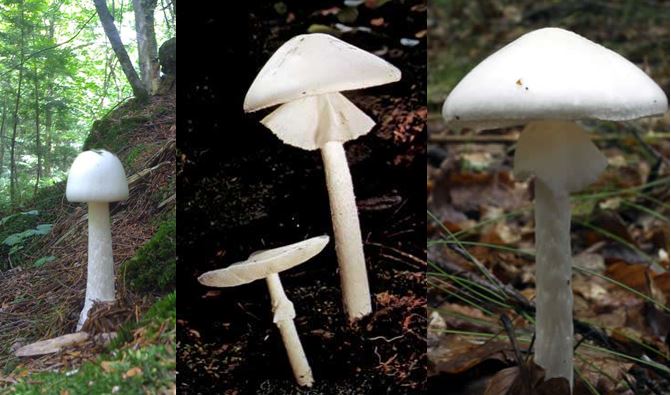
Destroying Angel (Amanita virosa)
Symptoms within 5- 24 hours of consumption:
-Intense stomach pain, diarrhoea and vomiting.
-What appears to be a full recovery after the first 3 symptoms.
-Followed by kidney and liver failure then death, a few days later.
Season: July – November
Location: North American. It grows on the floor in broadleaved woods in particular near birch trees.
Treatment: no antidote
As it matures the cap appears triangular and flatten. it has a thin looking sheet from the top of the stem below the cap.
In conclusion I may incorporate a character that seems to be effected, get better but then get worse in their condition or transformation.
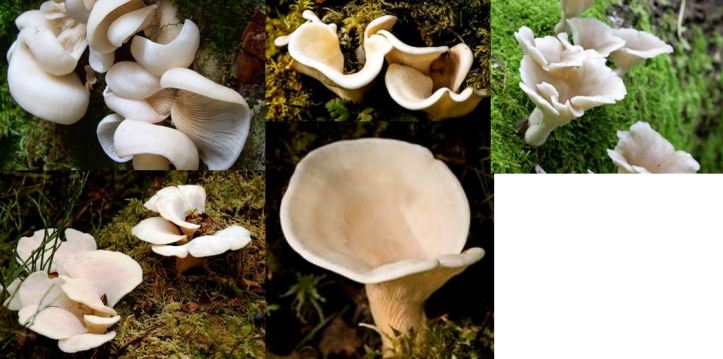
Pleurocybella porrigens
Nickname: Angel wings
Symptoms:
-death
-it contains a amino acid that kills off brain cells.
Season: autumn time
Location: northern hemisphere. They are commonly grown in cumbia and Scottish highland however it’s a rarity everywhere else.
They grow in damp conditions on the floor commonly where its’s covered by moss on decaying conifer wood. They are saprobic and normally grow in groups.
In some images they look like flower, with the cap being in thin layers compared to other variety of fungi.
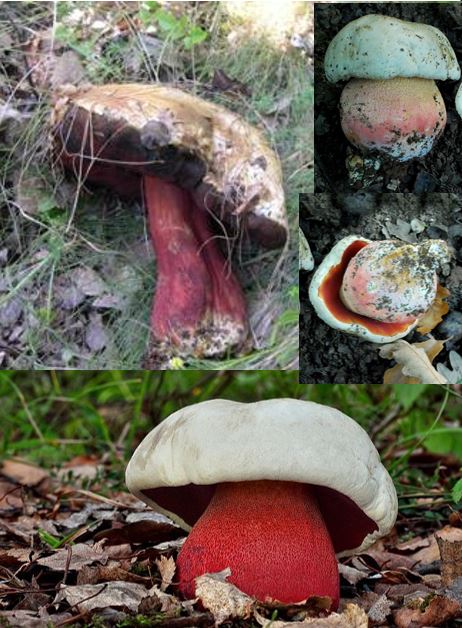
Satan’s bolete (boletus satanas)
Symptoms:
–hours of vomiting
-In rare cases it causes death.
When the flesh is bruised it turns blue.The stems appear red with the cap a grayish white colour. Cap size commonly grow to: 7- 30 cm.
Season its grown in: June till September
Location: in warmer climates that can be found on oaks in north America, beech in Europe and hardwood. In the northern hemisphere.
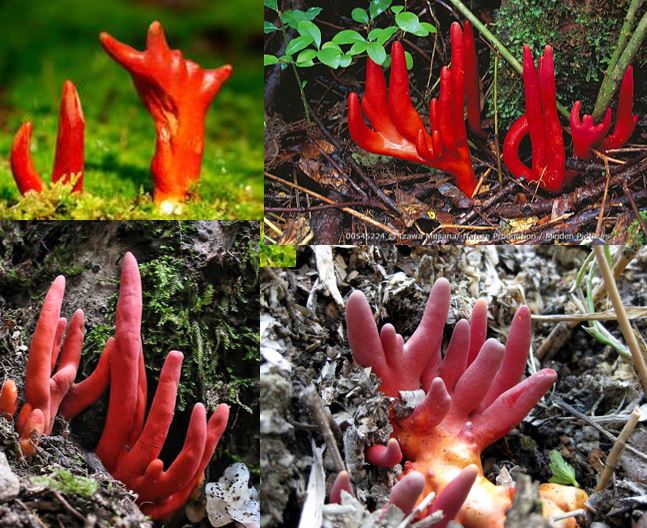
Podostroma cornu-damae
Symptoms:
–Death,
-severe multiple organ failure,
-acute kidney failure
-liver necrosis
-hair loss
-peeling skin just from touching it
-low blood pressure
– Stomach pains
-hallucinations
-dehydration
– effects consciousness
– speech impediments
Toxin: trichothecene mycotoxins
Location: Asia, number of deaths in Korea and japan. Found in china too.
During the early stages of growth the fungi resemble a health food “Ganoderma lucidum” there’s reports of it being so deadly a person who ingested 1g of the fungi with it soaked into a drink died.
They grow in branch like appearance on the ground with smaller stems growing off a larger stem, they are red in colour and have no clear caps.

Deadly Dapperling (Lepiota brunneoincarnata)
Symptoms:
-Death when untreated
-Liver failure
Locations: parts of Asia and Europe

Death cap (amantia phallodies)
The toxins can survive cooking temperatures.
After 6 – 24 hours of eating it people can have the following
symptoms:
-blood in their diarrhoea
– pain in their abdomen
– vomiting
– extreme thirst
– quick lost of fluid.
It can also cause damage to the: central nervous system, liver and kidneys. Blood sugars can plummet and decrease in urine production. 50% who ate this has know to have a coma then die. 9/ 10 times of mushroom poisoning is due to this mushroom because they look similar to the edible version. Worldwide this mushroom is the cause of one of the largest amount of deadly and fatal poisonings.
Location: they grow on the floor in the woods near broad leaf’s litter.
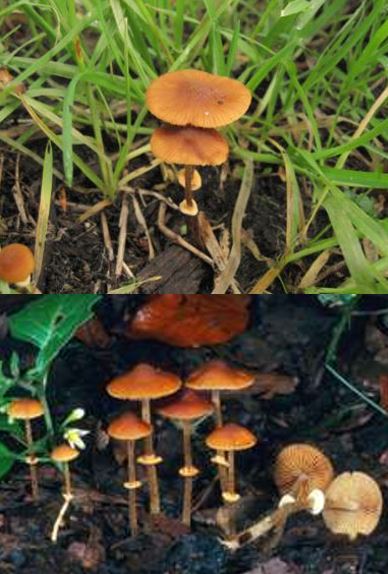
Fool’s Conecap (Conocybe filaris)
Symptoms liver failure. (it contains amatoxins).
Season it grows: June to October

Fool’s Funnel (Clitocybe rivulosa)
Symptoms:
-in rare cases it causes death.
-After consuming sweating and excessive salivation can occur
-stomach pain
-serve sickness
-diarrhea
-blurred vision
-difficulties breathing
Season: July to early December.
It commonly grows near the safe and edible “scotch bonnet”
location: grassy places, meadows and gardens.

Ivory Funnel (Clitocybe blanchi)
Nicknames: Sweating mushroom
Symptoms:
-Death is rare in people of good health
-vomiting
-Diarrhea
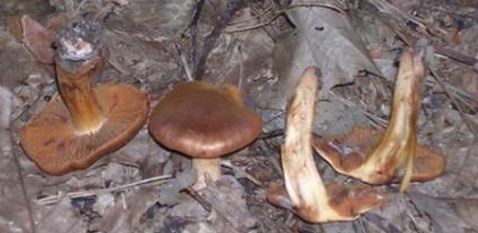
Fool’s Webcap (Cortinarius orellanus)
Symptoms:
-Symptoms can start after 2 or 3 days then last up to 3 weeks
-untreated can result to death
-Flu like symptoms
-renal failure ( that consists of serve thirst, frequent urination, kidney pain followed by lack of urination)
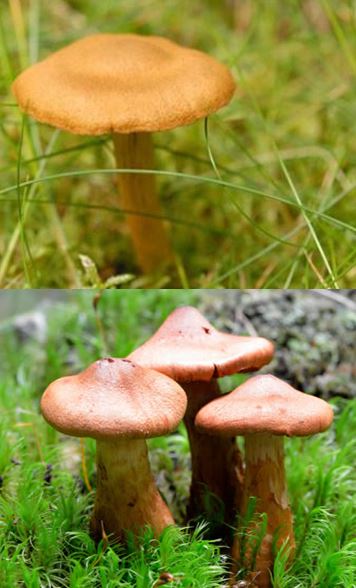
Deadly Webcap (Cortinarius rubellus)
Symptoms:
-Symptoms can start after 2 or 3 days then last up to 3 weeks
-untreated can result to death
-Flu like symptoms
-renal failure ( that consists of serve thirst, frequent urination, kidney pain followed by lack of urination )
Other info: contains poison called “orellanin” with the effects with a long duration.
Season: August to November
Location: across Europe however it’s a rarity in the uk. They grow on the ground near bilberry and heather in spruce woods and coniferous pine.
Treatment: no known antidote exists, hospital visit is advisable.

Galerina marginata
Nickname: funeral bell or autumn skullcap
They contain the same toxins as “Death cap” are small in size and brown in colour.
Symptoms:
they share the same symptoms as the “death cap”
As the name suggest they can cause death but beforehand they cause you to vomit and liver failure.
Season: august- November
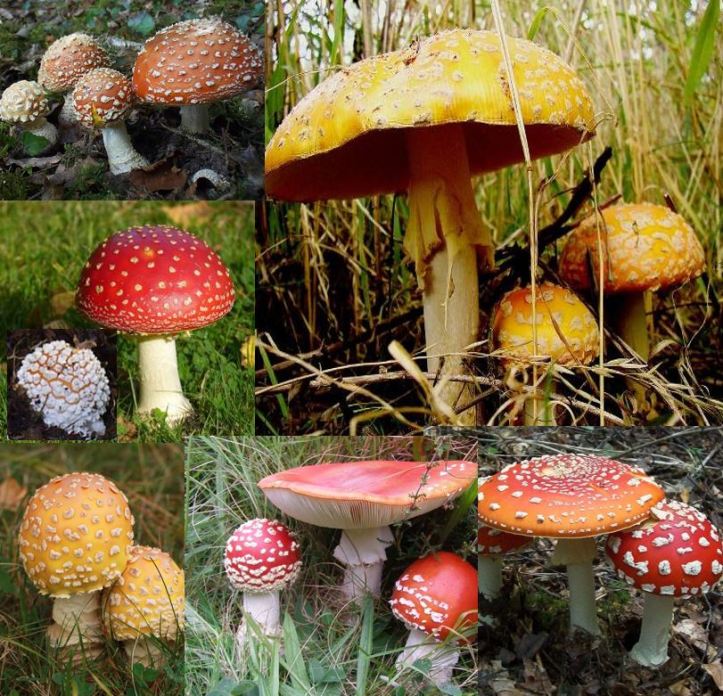
Fly Agaric (Amanita muscaria)
Symptoms:
-coma
-Seizures
-twitchiness
-Drowsiness
– delirium
Treatment:
Gastric lavage if within hour of poisoning, activated charcoal if within 4 hours of consumption.
Season: august – November in the uk
Other info: young mushrooms are doomed they flatten with age.
The gild and stem appear white or yellowish white when mature. They have white fragments on the top that can wash off in the wet weather.
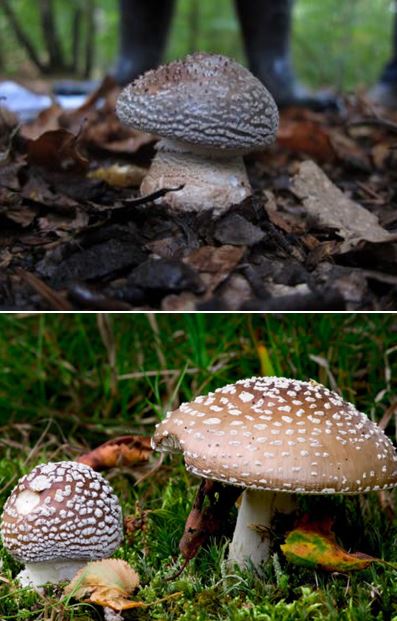
Panther Cap (Amanita pantherina)
symptoms:
They contain similar effects as the common Fly Agaric .
–In some cases it can cause death.
-Intense hallucinations, the illusion of the person having increased strength.
-effects the nervous system
-Severe illness
-convulsions
Season: July to November
Location: near oak or beech in broadleaved woods.
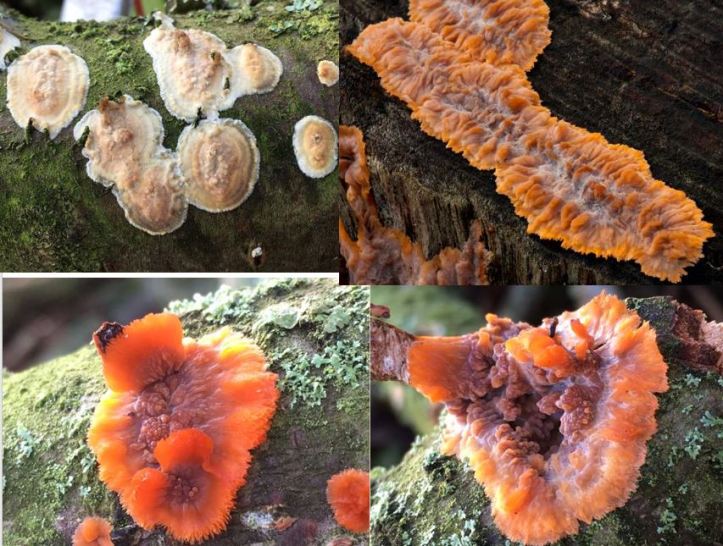
Wrinkled Crust
Inedible
Location: on dead confier timber, broadleaf trunks or fallen branches.
Season: autumn – winter
Size: the spores can go from 4cm – 5 cm.
Fritbody on average up to 10 cm a cross with a 1- 3 mm thickness.
The young mushroom are light pink then gets to a bright orange or brown with it getting light and hairy on the outer edge as it matures. The flesh has been said to be soft with the consistency of jelly.

Pholiota squarrosa
Nickname: Shaggy Scalycap or Scaly Pholiota
In Greek the word “Pholiota” translates to scaly.
Inedible
Poison classification :
class 5 Gastrointestinal irritant
Symptoms: short term gastrointestinal irritation that includes
-abdominal pain
-vomiting blood
-nausea
– black stools
-ingestion
-blood In the diarrhoea.
Treatment: in rare cases a IV fluid, intake of fluids. Commonly little is needed with the symptoms to die down after a few hours.
Season: summer till autumn.
Location: commonly grown across a majority of the uk, Usa, mainland Europe and parts of Canada.
All “Pholiota fungi” proses brown spores. The cap is pale yellow and on average grows from 4cm- 12cm. It looks round in appearance then flattens with age, the edges has a rolled over appearance to the gills. The stems on average grows from 7- 15cm in diameter. The gulls appear a pale yellowish grey then a brownish yellow as it ages. The surface has the appearance of bits peeling off.
The odor and tastes is said to be on the bitter taste and similar to radish.
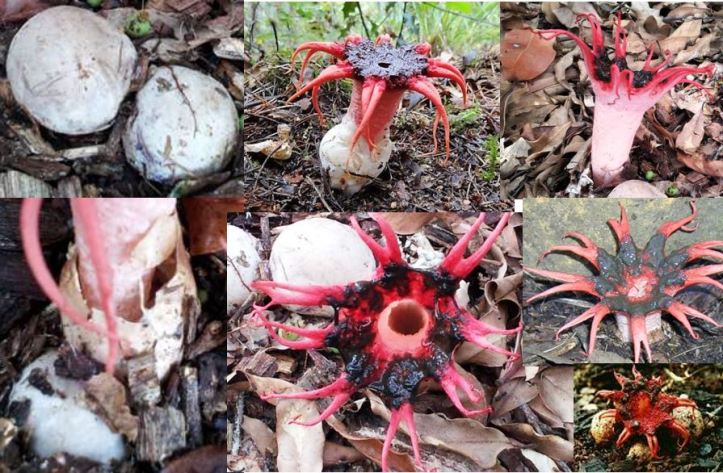
Nickname: starfish fungi, Stinkhorn fungi
Smell: they are said to give off a powerful stench that smells of sewage or rotting meat, the stench is not as powerful as “Clathrus archeri”
“Symptoms”
It has the toxicity category of 2
Most sources have cited this mushroom is not poisons however have known to causes deaths in small dogs. They are seen as gastros-irritants meaning they can in short term cause stomach pains, vomiting and diarrhoea.
They are said to be edible in the egg state however at the time of writing this I could not find if its poisonous as a mature fungi, some suggest it is but with no evidence.
Location: most common in tropical locations, Hawaii central America, south and north Carolina.
The fungi is saprobic and are commonly grown under shrubs and trees with fallen leaves and decaying wood.
Season: can appear year around however in summer till early autumn in southern England
This fungi looks similar to the creatures you see in “alien vs predator”
As a young fungi they appear as a pale grey egg 3cm in diameter. As it grows and matures the stem that is pink in colour emerge out of the egg shape called “volva” that appears as broken egg shells. As it matures the top opens out and it pairs have tentacle arm esc limbs spread out. Each tentacle arm is commonly grown from 3-5 cm in length.
The pale pink stem can grow up to 5- 9sm in length with a 3cm diameter and it tends to hollow inside as it ages. The inner top bit of the stem has a brownish slimily like substance at the top of the stem containing spores.
In conclusion: many of the poisonous mushrooms are named after: demons, angels, death, the word fool, have the word cap or webcap in its title. Majority of them cause: vomiting, diarrhoea, mainly liver and kidney failure then death. Many edible varsities have a poisonous variety lookalike or grow near them. Most fungi grow during the autumn and winter time, some are so toxic just from touching some varieties it can make your skin peel. Mushrooms can be parasites to each other, some share the same nickname so would have to look at the scientific name to differentiate them.
The poisonous mushrooms aren’t just colourful ones, there’s plenty dull looking ones that are also poisonous however majority of the more vivid or oddly shaped mushrooms are mainly either poisonous or inedible compared to the ratio for edible mushrooms. Edible mushroom have a larger percentage of dull looking mushrooms however they too have colourfull edible mushrooms. Found out not all mushrooms process a cap and when it does while its young they appear as a plump dome that eventually flattens out and change in colour as it ages majority of the time. Therefore the shape of the cap needs to be considered when thinking about hte age of the character.
References Anon, (2018). Two Cases of Mushroom Poisoning by Podostroma Cornu-Damae. [online] Available at: https://www.ncbi.nlm.nih.gov/pmc/articles/PMC3521283/ [Accessed 8 Oct. 2018]. Betterhealth.vic.gov.au. (2016). Mushroom poisoning. [online] Available at: https://www.betterhealth.vic.gov.au/health/healthyliving/fungi-poisoning [Accessed 8 Oct. 2018]. Betterhealth.vic.gov.au. (n.d.). Mushroom poisoning. [online] Available at: https://www.betterhealth.vic.gov.au/health/healthyliving/fungi-poisoning [Accessed 8 Oct. 2018]. BT.com. (2018). 10 of the UK's deadliest mushrooms. [online] Available at: http://home.bt.com/lifestyle/food/food-latest/10-of-the-uks-most-deadly-mushrooms-11363932698749 [Accessed 8 Oct. 2018]. Chawantake.sakura.ne.jp. (2011). Podostroma cornu-damae. [online] Available at: http://chawantake.sakura.ne.jp/data/Podostroma_cornudamae.html [Accessed 8 Oct. 2018]. Children’s Health Queensland. (n.d.). Stinkhorn fungi | Queensland Poisons Information Centre. [online] Available at: https://www.childrens.health.qld.gov.au/poisonous-plant-stinkhorn-fungi/ [Accessed 8 Oct. 2018]. Epic Wildlife News, Photos, & Videos. (2013). Bleeding Tooth Mushroom. [online] Available at: http://www.epicadamwildlife.com/2013/10/10/bleeding-tooth-mushroom/ [Accessed 8 Oct. 2018]. Fiedziukiewicz, M. (2013). Mushroom Toxins - The Meixner Test. [ebook] York: University of York, pp.8-107. Available at: http://etheses.whiterose.ac.uk/3958/2/Mushroom_Toxins_-_The_Meixner_Test.pdf [Accessed 8 Oct. 2018]. First-nature.com. (n.d.). Amanita muscaria, Fly Agaric mushroom. [online] Available at: https://www.first-nature.com/fungi/amanita-muscaria.php [Accessed 8 Oct. 2018]. First-nature.com. (n.d.). Aseroe rubra, Starfish Fungus identification. [online] Available at: https://www.first-nature.com/fungi/aseroe-rubra.php [Accessed 8 Oct. 2018]. First-nature.com. (n.d.). Clitocybe nebularis, Clouded Funnel mushroom. [online] Available at: https://www.first-nature.com/fungi/clitocybe-nebularis.php [Accessed 8 Oct. 2018]. First-nature.com. (n.d.). Mitrula paludosa, Bog Beacon fungi. [online] Available at: https://www.first-nature.com/fungi/mitrula-paludosa.php [Accessed 8 Oct. 2018]. First-nature.com. (n.d.). Pholiota squarrosa, Shaggy Scalycap Mushroom. [online] Available at: https://www.first-nature.com/fungi/pholiota-squarrosa.php [Accessed 8 Oct. 2018]. First-nature.com. (n.d.). Pleurocybella porrigens, Angel's Wings mushroom. [online] Available at: https://www.first-nature.com/fungi/pleurocybella-porrigens.php [Accessed 8 Oct. 2018]. Flickr. (2010). Fly Agaric (Amanita muscaria). [online] Available at: https://www.flickr.com/photos/anemoneprojectors/5039632310 [Accessed 8 Oct. 2018]. Hiddenforest.co.nz. (n.d.). Forest Fungi - Frequently Asked Questions. [online] Available at: http://www.hiddenforest.co.nz/fungi/fun/faq.htm [Accessed 8 Oct. 2018]. Holden, L. (2011). Mitrula paludosa (Bog Beacon) - Scottish Fungi. [online] Sites.google.com. Available at: https://sites.google.com/site/scottishfungi/species-profiles/mitrula-paludosa-bog-beacon [Accessed 8 Oct. 2018]. Holland, M. (2012). Yellow-orange Fly Agaric Mushroom. [online] Naturally Curious with Mary Holland. Available at: https://naturallycuriouswithmaryholland.wordpress.com/2012/10/16/yellow-orange-fly-agaric-mushroom/ [Accessed 8 Oct. 2018]. Imgur. (n.d.). Dangerously beautiful poisonous mushrooms. [online] Available at: https://imgur.com/gallery/hYDfG [Accessed 8 Oct. 2018]. Keating, H. (2016). Poisonous mushrooms: 7 of the most poisonous mushrooms in the UK. [online] Woodlandtrust.org.uk. Available at: https://www.woodlandtrust.org.uk/blog/2016/10/poisonous-mushrooms/ [Accessed 8 Oct. 2018]. Kitsteiner, J. (2013). Seventy Distinctive Mushrooms (Part Four: 31-40) | Temperate Climate Permaculture. [online] Tcpermaculture.com. Available at: http://tcpermaculture.com/site/2013/10/10/seventy-distinctive-mushrooms-part-four-31-40/ [Accessed 8 Oct. 2018]. Koichi M, Haruo T, Toshihiro Y, Masami O, Sadao N, Koichiro K (2003). "Case report: food poisoning to death by Podostroma cornu-damae, its case history and autopsy findings". Acta Criminologiae et Medicinae Legalis Japonica ( (1): 14–20. Mushroomexpert.com. (n.d.). Aseroe rubra (MushroomExpert.Com). [online] Available at: https://www.mushroomexpert.com/aseroe_rubra.html [Accessed 8 Oct. 2018]. Nahuby.sk. (n.d.). Nahuby.sk - Fotografia - hríb satanský Rubroboletus satanas f. satanas (Lenz) Kuan Zhao & Zhu L. Yang. [online] Available at: https://www.nahuby.sk/obrazok_detail.php?obrazok_id=535749 [Accessed 8 Oct. 2018]. Naturespot.org.uk. (n.d.). Wrinkled Crust | NatureSpot. [online] Available at: https://www.naturespot.org.uk/species/wrinkled-crust [Accessed 8 Oct. 2018]. Patouillard NT. (1895). "Enumeration des champignons recoltes par les RR. PP. Farges at Soulie, dans le Thibet oriental at le Su-tchuen". Bulletin de la Société Mycologique de France:196–99. Petruzzello, M. (n.d.). 7 of the World’s Most Poisonous Mushrooms. [online] Encyclopedia Britannica. Available at: https://www.britannica.com/list/7-of-the-worlds-most-poisonous-mushrooms [Accessed 8 Oct. 2018]. Pictures, M. (n.d.). Minden Pictures stock photos - Fungus (Podostroma cornu-damae) mushrooms, Japan - Izawa Masana/ Nature Production. [online] Minden Pictures. Available at: https://www.mindenpictures.com/search/preview/fungus-podostroma-cornu-damae-mushrooms-japan/0_00545224.html [Accessed 8 Oct. 2018]. Planet Deadly. (2013). Most Poisonous Mushrooms. [online] Available at: https://www.planetdeadly.com/nature/poisonous-mushrooms [Accessed 8 Oct. 2018]. Podostroma cornu-damae (Pat.) Hongo & Izawa 1994". MycoBank. International Mycological Association. [Accessed 8 oct 2018 ]. Revision of the Hypocreales with cultural observations. V. Podostroma giganteum Imai, P. cornu-damae (Pat.) Noedijn and Hypocrea pseudogelatinosa sp. nov". Reports of the Tottori Mycological Institute (Japan). : 421–27. 1973. Saccardo PA, Saccardo D (1905). "Supplementum universale. Pars VI. Hymenomycetae-Laboulbeniomycetae". Sylloge Fungorum 799. Saikawa Y, Okamoto H, Inui T, Makabe M, Okuno T, Suda T, Hashimoto K, Nakata M. "Toxic principles of a poisonous mushroom Podostroma cornu-damae". Tetrahedron : 8277–81. doi:10.1016/S0040-4020(01)00824-9. Sciencenetlinks.com. (2016). Weird & Wonderful Creatures: Bleeding Tooth Fungus - News - Science NetLinks. [online] Available at: http://sciencenetlinks.com/blog/snl-educator/bleeding-tooth-fungus/ [Accessed 8 Oct. 2018]. Survival Gear Masters. (n.d.). Poisonous Mushrooms: Were You Paying Attention in Skyrim? - Survival Gear Masters. [online] Available at: https://survivalgearmasters.com/poisonous-mushrooms-paying-attention-skyrim [Accessed 8 Oct. 2018]. Suzuki M, Katoh Y, Kumagai H, Saitoh M, Ishikawa H, Itoh H, Shimazu K (2002). "[Successful treatment in a case of Podostroma cornu-damae poisoning, a deadly poisonous mushroom]". Chudoku Kenkyu (2): 177–82. PMID 12108023. Toxinology.com. (n.d.). WCH Clinical Toxinology Resources. [online] Available at: http://www.toxinology.com/fusebox.cfm?fuseaction=main.poisonous_mushrooms.display&id=PM0108 [Accessed 8 Oct. 2018]. WebMD. (n.d.). Understanding Gastritis. [online] Available at: https://www.webmd.com/digestive-disorders/digestive-diseases-gastritis#1 [Accessed 8 Oct. 2018].